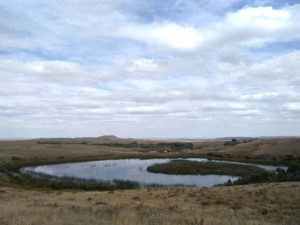 A low rumbling bellow echoes across the expanse of rolling prairie until it is swallowed by the deep recesses and waterways of a fen. The sheer volume of noise is enough to pause the conversations of the 13 members of WRFI’s Montana Afoot & Afloat 2018 course and our host, Dylan DesRosier. A lone cow paces behind a fence, desperately searching for a way to join its herd. The urgency and loneliness of their moo reverberates through our bodies and leaves us with a single question: Why on Earth are there cows here instead of bison?
A low rumbling bellow echoes across the expanse of rolling prairie until it is swallowed by the deep recesses and waterways of a fen. The sheer volume of noise is enough to pause the conversations of the 13 members of WRFI’s Montana Afoot & Afloat 2018 course and our host, Dylan DesRosier. A lone cow paces behind a fence, desperately searching for a way to join its herd. The urgency and loneliness of their moo reverberates through our bodies and leaves us with a single question: Why on Earth are there cows here instead of bison?
The hill we’re standing on is part of the Yellow Bird Woman Sanctuary, 1,200 acres of prairie and riparian ecosystems not commonly found on the East Rocky Mountain Front. Dylan, a Blackfeet tribal member and representative for the Nature Conservancy, had been sharing the importance of this place to the Blackfeet prior to the bovine interruption. The property was gifted to the Blackfeet by the Nature Conservancy because of its importance as a natural gathering site for the Native nation. It was later named after Elouise Cobell, a tribal representative who fought for compensation of funds stolen from members of federally recognized tribes across America by the Bureau of Indian Affairs, a branch of U.S. government responsible for the management of lands held in trust for Native American Tribes.
So, why cows? Cobell wanted her brother to use the property for cattle grazing. Cows can’t travel far from water and therefore have acute impacts on their surrounding wetlands, like this fen. The Blackfeet have regulations on the number of cows and the length of time they can graze here due to protect the delicate ecosystems and places of spirituality against degradation. These regulations also help prevent overgrazing of native grasses such a Kentucky Bluegrass and Idaho Fescue – Native Kentucky and Idaho in Montana? I digress…
Overgrazing: the plight of the prairie and the reason that so much of the U.S. now relies on feed-lot beef instead of free-range cattle. Courses in Conservation Biology have taught me that though feed-lots are economically efficient they subject their animals to filthy living conditions and release thousands of pounds of greenhouse gases into the air. Leo Bartholemess, a rancher in Phillips County Montana, acknowledges these environmental impacts but says he sends his livestock off to feed-lots to increase the profit margin, making his ranch financially viable. Many Montana based ranchers raise their herds on grassland but ship the cows to corn based feed-lots for finishing simply because one cow/calf pair in this area in the West needs 40 acres of free range a month; while a pair in many areas back East needs only one acre (Pollan 2002).
Fast-forward: The WRFI van, “Dolly”, is parked in a grocery store parking lot in Browning Montana.
WRFI rarely has the opportunity to stimulate academic learning with electronic media due to adventuring beyond service range. Data reception in this parking lot offered an exciting opportunity to utilize front country resources – YouTube! It might not seem like the most academic lesson, but the moral inspired this blog. A blocky, low-budget, 2000’s animation detailing dancing cows fills my phone screen while all 10 students crowd around to view the “lesson.” The video tells the story of cows in a feed-lot that conceptualize they’re being fattened for slaughter. Quirky anecdotal musical interludes of their tail (pun intended) of revolution and a catchy chorus of “cows with guns” interrupt the sad story. As the video plods on, armed cows rise up, only to be surrounded by determined executioners and the impending doom of McD’s whoppers…Who comes to the cows’ aid? Empathetic chickens in choppers!
Though it’s a silly video for a “classroom” setting, once you get past the ear-worm of a chorus, the moral is clear. In order to save ourselves from a livestock mutiny we must re-evaluate the way we consume our finite natural resources. Luckily for us at WRFI we visit places of significance like Yellow Bird Woman to experience place-based education, providing the necessary context to engage multiple perspectives on complex issues that impact human relationships with the environment. We now better understand the land and what it takes to be sustainable. We’ve gained more comprehensive understanding of the clarifying questions we should ask.
If you were wondering, yes, both the animated and actual cows escaped to join their respective cow communities with fates yet to be determined.
Daunting music ensues.
I retain hope that I will one day see bison returned to the open range. What would I, personally, be willing to sacrifice to aid this hope in coming to fruition? Not my dad’s beefy marinara! Food for thought…
Pollan, Michael. 2002. Power Steer. The New York Times Magazine, 31 March.
Link to “Cows With Guns” YouTube video